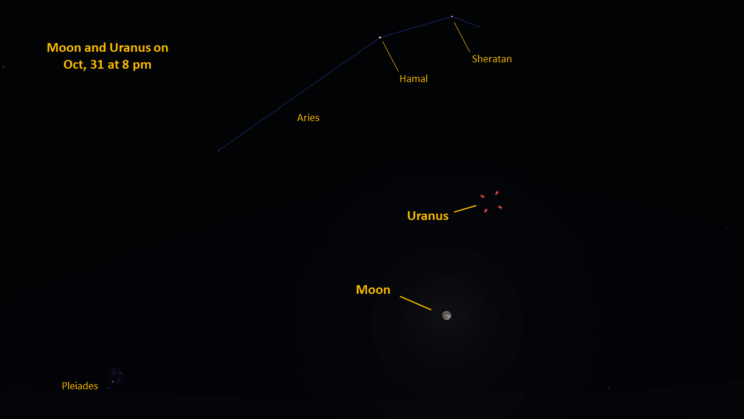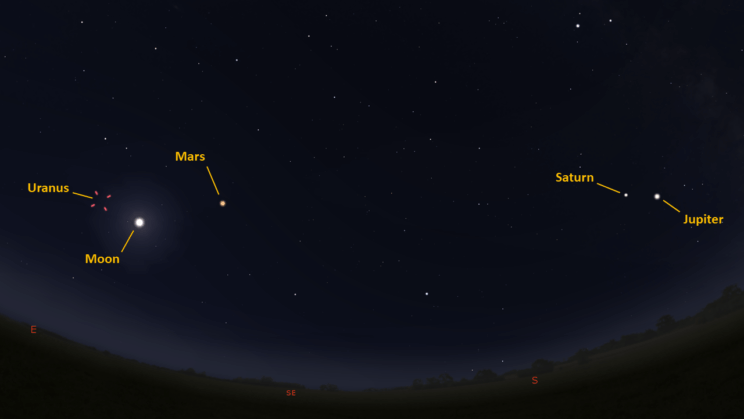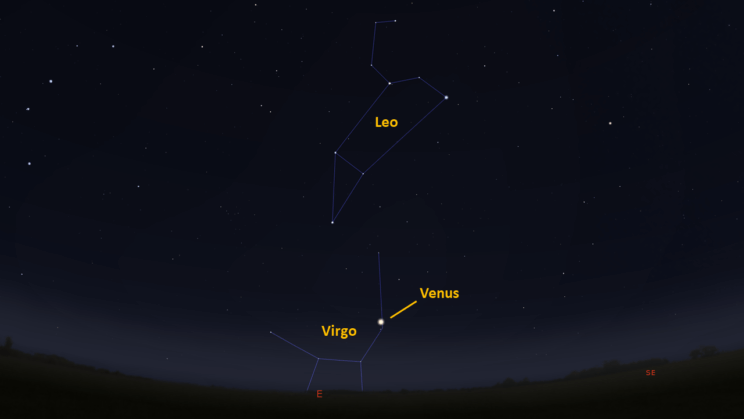This is the Saint Louis Science Center’s NIGHT SKY UPDATE for the week of Friday, October 30, 2020.
Information updated weekly or as needed.
Times given as local St. Louis time (CDT) until October 31. As of November 1, Daylight Saving Time ends, which means times will be posted in Central Standard Time (CST). For definitions of terminology used in the night sky update, click the highlighted text.
Public Telescope Viewings
Star parties at the Saint Louis Science Center have temporarily been canceled due to recommendations from the CDC regarding COVID-19. All public telescope events are canceled until further notice. As conditions change, we will reevaluate and update this article once public observing events resume.
Observing Highlight of the Week

Location of Uranus on October 31 at 8:00 pm
Credit: Stellarium, EG
The highlight for this week is the planet Uranus. Like the Moon, Uranus will reach opposition on Halloween this year. Opposition is when an object appears opposite of the Sun resulting in a brighter appearance. The brightening effect is caused when shadows cast by clouds or the features on the surface of the object are directed away from the viewer. This occurs because the object is located near the antisolar point. Like Jupiter, Saturn and Neptune, we see Uranus at opposition once every year.
Uranus was discovered in 1781 by William Herschel. On average Uranus is 1.8 billion miles from the Sun. It is the third largest planet in the solar system at roughly 4 times the size of Earth. It has a faint ring system and 27 moons. Perhaps the strangest feature of Uranus is its rotation. Uranus’s axis of rotation appears to be tilted nearly 90° from is orbital plane. The result of this tilt is extreme seasons. Summer and winter on Uranus last roughly 21 years. A day on Uranus is about 17 hours and a year is equal to 84 Earth years.
To find Uranus in St. Louis you will need binoculars and a map of its location. The giant world is currently found in the constellation Aries. Your best bet to find Uranus will be to locate the two brightest stars in Aries named Hamal and Sheratan. Once you can identify these, Uranus is about 10° south of Sheratan. If you think you have found Uranus but are not sure, make a sketch of the planet’s location and the stars around it then find it again a few nights later. Remember, the name planet means wanderer and as such you should see that Uranus has moved a little compared to the star field. If you look for Uranus on October 31, it will be about 5° north of the Moon. This may seem easier but the bright moon will make Uranus harder to see. The current magnitude for Uranus is 5.7 and as such will be an easy target for binoculars.
The Sun and Moon

The Moon as seen from the International Space Station, on July 31, 2011.
Credit: NASA
Sunrise is at 7:26 a.m. on Friday, October 30 and sunset is at 6:03 p.m. providing us with roughly 10.5 hours of daylight. Even after sunset, the light from the Sun will dimly illuminate our sky for about 1 hour and 30 minutes. This period is called twilight, which ends around 7:32 p.m. this week. For those with a sundial, local noon occurs around 12:45 p.m. this week.
On November 1, Day Light Saving Time ends. Remember to set your clocks one hour back as we start using Central Standard Time. If relying on times posted in Universal Time (UT), St. louis is now -6 Hours from UT.
| Day | Sunrise | Sunset |
|---|---|---|
| 2020-10-30 | 7:26 a.m. | 6:03 p.m. |
| 2020-10-31 | 7:27 a.m. | 6:01 p.m. |
| 2020-11-01 | 6:29 a.m. | 5:00 p.m. |
| 2020-11-02 | 6:30 a.m. | 4:59 p.m. |
| 2020-11-03 | 6:31 a.m. | 4:58 p.m. |
| 2020-11-04 | 6:32 a.m. | 4:57 p.m. |
| 2020-11-05 | 6:33 a.m. | 4:56 p.m. |
| 2020-11-06 | 6:34 a.m. | 4:55 p.m. |
| 2020-11-07 | 6:35 a.m. | 4:54 p.m. |
Moon
Moonrise for Friday, October 30 occurs at 5:57 p.m. and moonset will occur at 7:19 a.m. on the following day. On Friday, October 30 the Moon will exhibit a waxing gibbous phase with 99% of the lunar disk illuminated. The second full moon for October occurs on October 31 at 9:49 a.m.
The full moon this Halloween is also a Blue Moon. When two full moons occur in a month, the second full moon is called a Blue Moon. This happens roughly every 2 to 3 years and is the most common interpretation of a Blue Moon. The lunar term “Blue Moon” first appears in a Maine farmer’s almanac from the 1930’s. It defines a Blue Moon as the occurrence of four full moons in one season. If this happens the third full moon is the Blue Moon. Later this was misinterpreted by the author of a 1946 article in Sky and Telescope that described Blue Moons as the second full moon of a month. The mistaken interpretation continued to be popular and has stayed in the minds of most modern observers. The Blue Moon on October 31 is a monthly Blue Moon, and the next seasonal Blue Moon occurs on August 22, 2021.
Blue Moons occur because we use a solar calendar that is 365.24 days long. At one time most calendars were determined by the Moon. One synodic cycle of the Moon occurs every 29.5 days. This is determined by the time it takes the Moon to go from one new moon to the next. This is called a synodic month with the term synodic meaning meeting. In this case the meeting is between the Sun and Moon in the sky. A month is a cycle of the Moon with the most familiar being the synodic month. Other types of months are draconic (node to node) and anomalistic (perigee to perigee).
A year based on the moon phases is only 354 days long. Eventually, culture developed agrarian lifestyles and a dependence on the Sun to keep time became more important. During the transition to a solar calendar several lunisolar calendars were created. For these to function intercalary months had to be added. In some cases, these were shortened months added to complete the solar year or in some cases a complex system of intercalary months were added to certain years. Two famous examples of this are the Chinese and Hebrew lunisolar calendars still in use today. Since our modern calendar is solar based, we experience roughly 12.4 lunar months a calendar year. We balance this out by having months that are 31, 30 and 28/29 days long. This is the cause of Blue Moons.
International Space Station (ISS) Observing

Visible passes of ISS from St. Louis for the week of October 30 occur during morning hours. The best passes this week occur on November 5 and 7. Use the table below for information about these and other visible passes this week.
Catch ISS from St. Louis starting Friday, October 30
| Date | Starts | Max. altitude | Ends | |||||||
|---|---|---|---|---|---|---|---|---|---|---|
| Time | Alt. | Az. | Time | Alt. | Az. | Time | Alt. | Az. | ||
| 03 Nov | -1.3 | 05:59:53 | 10 | NNW | 06:01:57 | 15 | NNE | 06:04:02 | 10 | ENE |
| 05 Nov | -2.1 | 06:00:33 | 10 | NNW | 06:03:30 | 28 | NNE | 06:06:27 | 10 | E |
| 06 Nov | -1.6 | 05:13:41 | 13 | NNW | 05:15:33 | 20 | NNE | 05:18:06 | 10 | ENE |
| 07 Nov | -1.1 | 04:27:58 | 15 | NNE | 04:27:58 | 15 | NNE | 04:29:35 | 10 | ENE |
| 07 Nov | -3.6 | 06:01:26 | 10 | NW | 06:04:48 | 73 | NE | 06:08:09 | 10 | ESE |
Magnitude (Mag): The Measure of brightness for a celestial object. The lower the value is, the brighter the object will be.
Altitude (Alt): The angle of a celestial object measured upwards from the observer’s horizon.
Azimuth (Az): The direction of a celestial object, measured clockwise from an observer’s location with north being 0°, east being 90°, south being 180° and west being 270°.
For information about ISS flyovers and other visible satellites, visit www.heavens-above.com
Detailed information regarding all unmanned exploration of our universe, missions past, present, and planned, can be found at Jet Propulsion Laboratories:
The Visible Planets

Looking Southeast, at 8:00 pm, October 30, 2020
Credit: Stellarium, EG

Looking East, 5:30 am, October 31, 2020
Credit: Stellarium, EG
This week, four naked eye planets are visible. Jupiter and Saturn rise before sunset. Look for them in the south once it is dark. Mars rises before sunset and will be best seen at midnight. Venus can be found in the eastern sky before sunrise.
For those tracking Jupiter and Saturn as they approach their great conjunction later this year, the two gas giants currently appear about 5.08° apart in the sky. From now until December 21, Jupiter will appear closer to Saturn each night.
Venus
Venus is well into another morning apparition. After months of seeing Venus in the west after sunset Venus is now visible in the east before sunrise. Venus rises at 4:35 a.m. and will be easily seen by 5:30 a.m. Venus remains a morning object until March 26, 2021 when it reaches superior conjunction. Since Venus has passed greatest western elongation, it will start to exhibit a gibbous phase.
Mars
Mars has passed opposition and now rises before the Sun. Surface features will still be visible through telescopes for some time, but Mars will start to fade as Earth is now moving away from Mars. Observing season for this apparition ends around March 10, 2021 and superior conjunction occurs on October 7, 2021. Currently Mars appears as a -2.2-magnitude object that will be visible in the east about 30 minutes after sunset. Mars will set by 5:43 a.m.
Jupiter
Look for Jupiter in the south about 30 minutes after sunset. Jupiter will set at 10:35 p.m. Those with a telescope can enjoy views of Jupiter’s cloud features and the Great Red Spot when it is pointed towards Earth.
Saturn
Look for the ringed planet in the south about 30 minutes after sunset. Saturn sets at 11:01 p.m. For those with a telescope keep track of the orientation of Saturn’s rings. Since Saturn is tilted on its rotational axis, we cross the plane of Saturn’s ring every 13 to 15 years. We are headed towards another ring plane crossing on March 23, 2025. Over the next five years you will notice Saturn’s rings will gradually incline towards an edge on appearance.
Uranus
Uranus is not a planet we normally include in this section. Even at its dimmest, the giant planet does hover within naked eye visibility. That said, it is so close to the visible limit of the human eye it just is not reality for most of us to hope to see Uranus without the aid of binoculars or a telescope. You can find Uranus in the constellation Aries the Ram rising around 6:02 p.m.
Like other planets, when at opposition, Uranus will appear brighter than it normally does. As we approach opposition with Uranus it will shift from a visual magnitude of 5.9 to 5.7. That extra bump in magnitude makes all the difference as it is now easy to see in binoculars. The current magnitude for Uranus is 5.7. Uranus will reach opposition on October 31, so grab those binoculars and try to spot the 3rd largest planet in our solar system. You can find a finder chart for Uranus here
2020 Great Conjunction
This year the planets Jupiter and Saturn will reach conjunction. A conjunction is when two or more celestial bodies share the same right ascension. For Jupiter and Saturn this astronomical event occurs every 20 years. The conjunction occurs on December 21, 2020. You will find the two planets close together in the southwest just after sunset on this date.
Visit the James S. McDonnell Planetarium for more information on what’s up!
Night Sky Update: October 30-November 7, 2020






